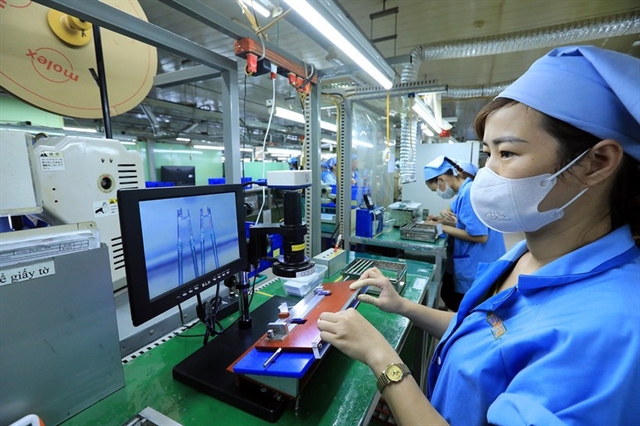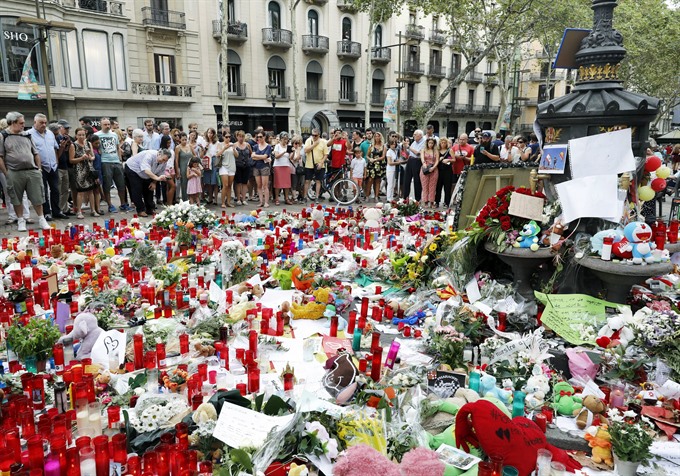 World
World

Spanish police said on Sunday they had uncovered a cache of 120 gas canisters at a house believed to be the bomb-making factory of suspects in terror attacks that claimed 14 lives, as Barcelona mourned victims of the rampage.
 |
| People pay their respect to the victims outside the Liceu Theatre, on the site of a deadly van attack in Barcelona, Spain, 20 August 2017. At least 14 people were killed and some 130 others injured after cars crashed into pedestrians on the La Rambla boulevard in Barcelona and on a promenade in the coastal city of Cambrils on 17 August. — EPA/VNA Photo |
BARCELONA — Spanish police said on Sunday they had uncovered a cache of 120 gas canisters at a house believed to be the bomb-making factory of suspects in terror attacks that claimed 14 lives, as Barcelona mourned victims of the rampage.
The suspected jihadists had been preparing bombs for "one or more attacks in Barcelona", regional police chief Josep Lluis Trapero told reporters, revealing that traces of TATP explosive had also been found.
But the suspects accidentally caused an explosion at the house on the eve of Thursday’s attack in Barcelona -- an error that likely forced them to modify their plans.
Instead, they used a vehicle to smash into crowds on Barcelona’s Las Ramblas boulevard as it was thronged with tourists, killing 13 people and injuring about 100.
Several hours later, a similar attack in the seaside town of Cambrils left one woman dead. Police shot and killed the five attackers in Cambrils, some of whom were wearing fake explosive belts and carrying knives.
The Islamic State (IS) group claimed responsibility for the attacks, believed to be its first in Spain.
Police are hunting a 22-year-old Moroccan man, Younes Abouyaaqoub, suspected of driving the van used in Barcelona. They warn he could be at large outside Spain.
’No music, no children, no women’
In the small town of Alcanar, investigators combed the rubble of a house believed to be the suspects’ bomb factory, and where the gas canisters were uncovered.
Traces of triacetone triperoxide (TATP) -- a homemade explosive that is an IS hallmark -- were also found at the house.
A neighbour, 61-year-old French retiree Martine Groby, said that four men "who all speak French" had been in the house next door since April.
"They were very discreet, too discreet. The shutters were closed, there was no music, no children, no women," she recalled.
"Sometimes they would stay just two days and they would leave. They said hello to me but never looked me in the eye."
Imam’s role?
Investigators said they believe the terror cell comprised at least 12 men, some of them teenagers.
An imam, Abdelbaki Es Satty, is among the suspects, police confirmed.
He is believed to have radicalised youths in Ripoll, a small town at the foot of the Pyrenees, where several suspects -- including Abouyaaqoub -- grew up or lived.
On Saturday, police raided the imam’s apartment there. Investigators are also looking for DNA traces to see if the imam may have been blown up in the explosion in Alcanar.
The imam was reportedly known to police, with Spanish media saying he had spent time in prison.
El Pais and El Mundo said the imam had met prisoners linked to the Al-Qaeda-inspired bombing of Madrid trains that killed 191 people in March 2004 in what remains the worst terror attack in Europe.
Nordeen El Haji, 45, who four months ago moved into the apartment that Satty occupied, said that "on Tuesday morning, (the imam) left saying that he was going on vacation to Morocco".
"He spoke little, spent most of the time with his computer in his room, and had an old mobile phone with no internet, and few books," said Satty’s flatmate.
’Brainwashed’
In the Moroccan town of M’rirt, relatives of Abouyaaqoub accused the imam of radicalising the young man, as well as his brother Houssein.
"Over the last two years, Younes and Houssein began to radicalise under the influence of this imam," their grandfather said.
Most of the suspects are children of Moroccan immigrants, including Ripoll-born Moussa Oukabir, 17, one of five suspects shot dead in Cambrils. His older brother Driss is among the four arrested.
A cousin said Moussa "loved playing football, having a good time, chatting up girls".
"The last few months, he started to become interested in religion. He used to go to a mosque in Ripoll. Maybe that’s where he was brainwashed," the cousin said.
Snipers on rooftops
Three days after the attack that plunged the country into deep grief, locals and tourists turned out in force on Sunday at Barcelona’s Sagrada Familia basilica.
King Felipe, Prime Minister Mariano Rajoy and Catalonia’s president, Carles Puigdemont, led a 90-minute ceremony commemorating the victims, who came from three dozen countries, some as far afield as Australia, China and Peru.
In the evening, local football heroes FC Barcelona staged a minute’s silence at the 99,000-capacity Camp Nou stadium for their first game of the league season, against Seville-based Real Betis.
Barcelona stars including five-time World Player of the Year Lionel Messi wore shirts with "Barcelona" replacing individual names on the back, while their opponents donned shirts with the message "Real Betis with Barcelona."
In Paris, a mass in Notre-Dame Cathedral was attended by the city’s mayor, Anne Hidalgo and France’s minister of European affairs, Nathalie Loiseau.
The list of individual tragedies lengthened as a seven-year-old British-Australian boy, Julian Cadman, who had been named as missing, was confirmed as being among the 13 killed in Barcelona.
"He was so energetic, funny and cheeky, always bringing a smile to our faces," his family said.
"We are so blessed to have had him in our lives and will remember his smiles and hold his memory dear to our hearts." — AFP